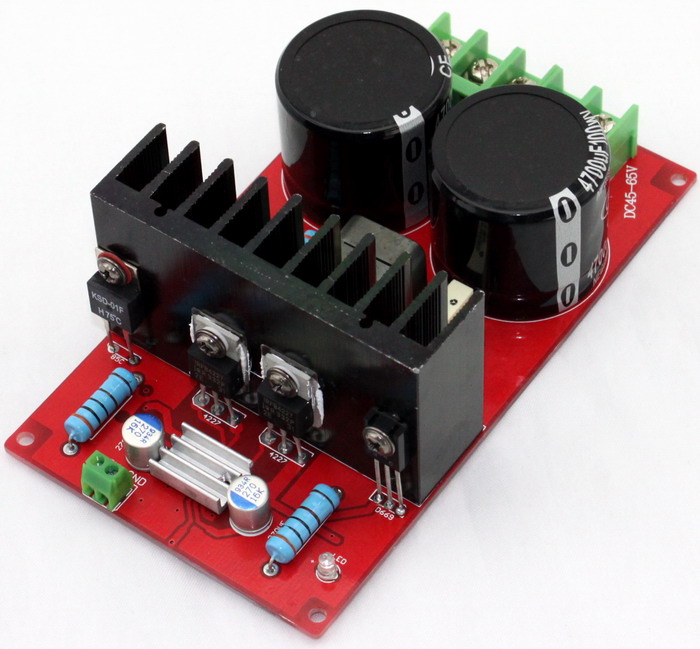Yup, always a good proposal....t106-2...
Txxx-2 suits for the very most class D amps these days.
Did reading on LC filter of Class D amps. Increasing capacitance and/or decreasing induction increases quiescent current.
source: Texas Instruments - Reducing and Eliminating the Class-D Output Filter : http://www.ti.com/lit/an/sloa023/sloa023.pdf
A thread on modifying LC output filter to improve audio: http://www.diyaudio.com/forums/class-d/170059-inexpensive-yuanjing-tda8920-board-ebay.html
As zog666 has done decrease the inductance (from 22uH to 11uH) & increase the capacitance (from 0.47uf to 1uf)
The board has 470nf capacitor = 0.47uf (not 0.047uf as I mistakenly mentioned before).
Hence for a slight increase in quiescent current would it handle greater power ?
source: Texas Instruments - Reducing and Eliminating the Class-D Output Filter : http://www.ti.com/lit/an/sloa023/sloa023.pdf
A thread on modifying LC output filter to improve audio: http://www.diyaudio.com/forums/class-d/170059-inexpensive-yuanjing-tda8920-board-ebay.html
As zog666 has done decrease the inductance (from 22uH to 11uH) & increase the capacitance (from 0.47uf to 1uf)
The board has 470nf capacitor = 0.47uf (not 0.047uf as I mistakenly mentioned before).
Hence for a slight increase in quiescent current would it handle greater power ?
Last edited:
The board is designed to handle split supply between 45v to 65v.


I double-checked the DC filtered output before connecting it to the amp. It was steady at +-55v (=40v AC x1.375). Moreover, the blue LED on amp board came on indicating its working fine. Total capacitance is around 24,700uf per rail (10,000ufx2 on rectifier board + 4,700 on amp board)
Since it failed due to excess current draw, there is no current limiting.


I double-checked the DC filtered output before connecting it to the amp. It was steady at +-55v (=40v AC x1.375). Moreover, the blue LED on amp board came on indicating its working fine. Total capacitance is around 24,700uf per rail (10,000ufx2 on rectifier board + 4,700 on amp board)
Since it failed due to excess current draw, there is no current limiting.
Last edited:
Since it failed due to excess current draw, there is no current limiting.
Do we know that? (both that it failed due to excess current, and that there is no current limiting)
Well I tried repairing the board with 2x compact Nickel Zinc Ferrite 6A 22uH coils in parallel. The MUR160 fast recovery diodes were also shorted (circled white). Replaced those too.
Now the blue led doesn't turn on & a 1-second pulsating beat is heard though the speaker. The blue does turn on for 1/2 a sec while powering down. I guess I'll have to throw this board in the dustbin.
An externally hosted image should be here but it was not working when we last tested it.
Now the blue led doesn't turn on & a 1-second pulsating beat is heard though the speaker. The blue does turn on for 1/2 a sec while powering down. I guess I'll have to throw this board in the dustbin.
Last edited:
The issue with this board is that the pre-driver stage is made of SMD components making repair a difficult process
An externally hosted image should be here but it was not working when we last tested it.
Now the blue led doesn't turn on & a 1-second pulsating beat is heard though the speaker. The blue does turn on for 1/2 a sec while powering down. I guess I'll have to throw this board in the dustbin.
That could be the IC resetting due to over current event.
The irs2092 does a similar thing of output is shorted.
Hi,
I would like to learn from the above, however, most of the "tech-talk" is way over my head! So, may I ask if anyone can offer some advice, specific to my problem?
I have built a TDA7491HV amp. I have attached a section from the application note as reference. The LC values I have used (for 4ohm speakers) is 15uH/470nF. Not knowing any better I have use a Coilcraft MSS7331-153MLB inductor (Farnell Ord Code 2526866). This is running at over 60C! Cheepie eBay samples using this same circuit run "cold" So I guess I'm doing something wrong.
I note one comment in the above thread: "That there are specifically designed inductors for Class D use" Should I be looking for one of these? Or am I on the wrong track?
Any advice will be most welcome.
Regards, Martin
PS Although ordered as 15uH, my inductors are marked "153". Can this be right? Should it not be "150"?
I would like to learn from the above, however, most of the "tech-talk" is way over my head! So, may I ask if anyone can offer some advice, specific to my problem?
I have built a TDA7491HV amp. I have attached a section from the application note as reference. The LC values I have used (for 4ohm speakers) is 15uH/470nF. Not knowing any better I have use a Coilcraft MSS7331-153MLB inductor (Farnell Ord Code 2526866). This is running at over 60C! Cheepie eBay samples using this same circuit run "cold" So I guess I'm doing something wrong.
I note one comment in the above thread: "That there are specifically designed inductors for Class D use" Should I be looking for one of these? Or am I on the wrong track?
Any advice will be most welcome.
Regards, Martin
PS Although ordered as 15uH, my inductors are marked "153". Can this be right? Should it not be "150"?
Attachments
- Status
- Not open for further replies.
- Home
- Amplifiers
- Class D
- The common class d output filter inductance overheating problem.
